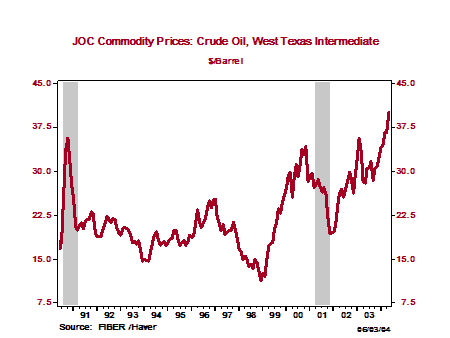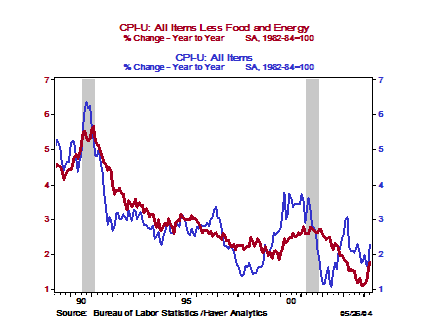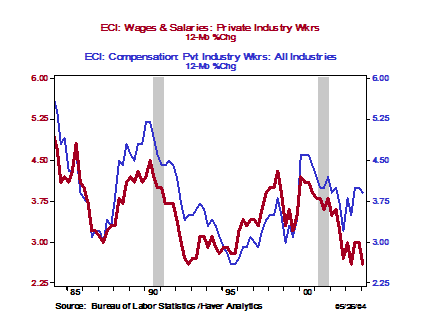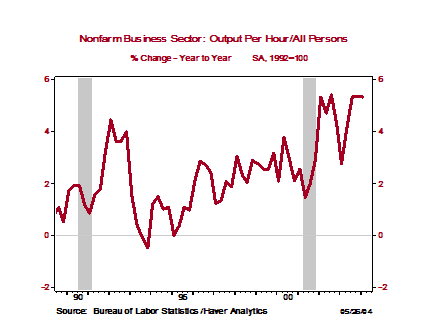Yours is a timely question given the renewed strength in the economy, recent upward movements in inflation rates, and the combination of very accommodative monetary and fiscal policies we saw in early 2004. Current forecasts for the U.S. economy suggest that inflation may increase somewhat in 2004. For example, the May 2004 FedViews forecast (released monthly on the Federal Reserve Bank of San Francisco’s web site) suggested that, "…inflation will rise a bit more as the economy expands, to the 1.5 plus percent range." See FedViews for the most recent FRBSF forecast.
Higher fuel prices pushed up the inflation rate in early 2004
While there has been an upturn in the inflation rate in 2004, much of that increase probably reflects the recent run up in oil and fuel prices, shown in Chart 1, rather than rising wages.The overall inflation rate on a year-over-year basis has risen recently (shown as the thin blue line in Chart 2). Even the core Consumer Price Index (CPI) inflation rate (shown as the heavy red line in Chart 2), a series that measures inflation excluding the volatile food and energy components, has risen in recent months as higher energy prices are reflected in the prices of other goods and services. Still, as of April 2004, the core inflation rate remained below a 2 percent annual rate of increase on a year-over-year basis. One reason the core inflation rate (red line in Chart 2) is a better measure of inflation trends is that it does not show as much volatility over time as the total CPI index. As can be seen from Chart 2, the overall CPI index is more prone to being driven up and down by short-term movements in volatile food and energy prices than is the core CPI.
Chart 1

Chart 2

Wages rising, but not much faster
Now, let’s go back to your question about the pattern of wage and salary increases—this is a good indicator to watch as economic growth improves. One measure of how rapidly wages are changing is the year-over-year increase in the Employment Cost Index (ECI). As illustrated by the heavy red line in Chart 3, the year-over-year percentage change in the ECI for wages for all industries remained relatively low, below 3 percent, through the first quarter of 2004. So, while wages are increasing, as the question noted, the increases remain relatively modest, especially when compared to productivity growth.
In contrast, benefits increases have been rising more rapidly than wages, enough to move the ECI for total compensation (includes wages, salaries, and benefits) up over the past year, shown as the thin blue line in Chart 3. Still, even the increase in total compensation on a year-over-year basis remained below 4 percent during the first quarter of 2004. These findings are consistent with the recent anecdotal information that is available from the April 21, 2004 Beige Book (Current Economic Conditions by Federal Reserve District published eight times each year). With respect to wage inflation, the national Beige Book survey reported that, "…increases in wages and salaries were modest; however, significant increases in the cost of health benefits were noted."
Chart 3

Rapid productivity growth continues in early 2004
The economy’s continued rapid increases in productivity, shown in Chart 4, are key to its ability to expand at a brisk pace without creating upward pressure on the overall price level. Rapid productivity growth allows output to increase, employee compensation to rise, and the economy to expand faster with less inflationary pressure. Because productivity growth has been rising faster than labor compensation, it has been putting downward pressure on prices.1
Chart 4

How has Fed policy reacted to the renewed strength in the economy in 2004?
Finally, you asked: "What can the Fed do to counteract a rise in the overall inflation rate?" The short answer is to begin to tighten monetary policy; evidence of such action would be announced as an increase in the federal funds rate target. Currently at 1 percent, the target rate is at a 45-year low. As noted in recent editions of FedViews, the Federal Open Market Committee (FOMC) has "tried to be transparent in its intentions through its public policy statements." The May 2004 edition of FedViews notes the shifts in the FOMC’s intentions during 2004 by quoting from recent FOMC Meeting Statements.
In January, when robustness of the economy was still in some doubt, the Federal Reserve announced it would keep rates low "for a considerable period." In March, as the economy showed more signs of improving, the Fed said it would be "patient" about raising rates. Last week, the FOMC removed the reference to being "patient" and stated that rates will be raised "at a pace likely to be measured," interpreted as a slow and steady series of increases dictated by the economic data.
References
(urlsaccessed on June 2004)
Beige Book. Board of Governors of the Federal Reserve System
http://www.federalreserve.gov/fomc/beigebook/2004/default.htm
Federal Open Market Committee. "FOMC Meeting Statement Press Release," Board of Governors of the Federal Reserve System
http://www.federalreserve.gov/fomc/#calendars
FedViews. Federal Reserve Bank of San Francisco
/publications/economics/fedviews/index.html
U.S. Monetary Policy: An Introduction. 2004. Federal Reserve Bank of San Francisco
/publications/federalreserve/monetary/index.html
Endnotes
1. As was noted in the June 11, 2004 FedViews: "Rapid productivity growth has contributed to declining labor costs, putting downward pressure on prices. Over the past two years, labor productivity growth averaging 4 percent per year has outpaced labor compensation growth of 3-1/2 percent, causing unit labor costs to fall by one half percent on average per year."